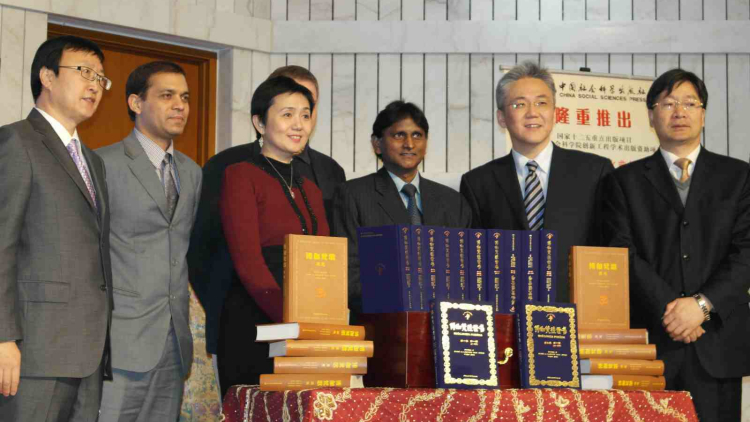Bhagavad-gita As It Is and Bhagavata Purana Released in Chinese
By ISKCON News Staff | Янв 24, 2014

On Januray 7th, 2014, the China Social Sciences Press proudly announced the historic release of two ancient cultural classics of India: Бхагавата Пураны и Bhagavad-gita As Is.
As per the website of the Indian Embassy in Beijing, the China Social Sciences Press (CSSP) hosted a press conference in the Indian Embassy in Beijing on January 7, 2014, to announce the release of two ancient Cultural classics of India: the Бхагавата Пураны and the Bhagavad-gita.
The news has also been relayed by over 15 news websites in China.
CSSP is the publishing wing of the Chinese Academy of Social Sciences, which is the premier and the most comprehensive academic research organization and national center in the People’s Republic of China (PRC) for study in the fields of philosophy and social sciences. It was described by Foreign Policy magazine as the top think tank in Asia. It is affiliated with the PRC’s State Council.
CSSP recently celebrated 35 years of activity. For over three decades CSSP has published a large number of outstanding scholarly publications, winning the approval of a wide readership both at home and abroad and enjoying a high-grade reputation in the academia. In the recently released third edition Government Publishing Award List, CSSP appears four times, making it the most decorated publisher nationwide. Previously, the direct translation of the Mahabharata from Sanskrit to Chinese won the CSSP its first government publishing award.

CSSP representatives talk about the importance of the two released works.
Specializing in academic publications, CSSP has always placed great importance on publishing the cultural fruits of ancient India. CSSP has to date published over 30 scholarly books on India’s rich culture and studies and research into its history, including translations of the Upanisads by Mr. Huang Baosheng and the "Бхагавад-гита" by Mr. Xu Fancheng—books translated directly from the Sanskrit original works into Chinese.
The two classics released recently—the Бхагавата Пураны и "Бхагавад-гита как она есть"—are works authored and translated into English by Indian Sanskrit master A.C. Bhaktivedanta Swami, and translated into Chinese in simplified characters by Jahnava Devi, Chief Translator & Editor in the Chinese Division of the Bhaktivedanta Book Trust.
The entire translation project—13.3 million Chinese characters—will be completed in two phases: the first phase will be the publication of cantos 1 to 9 into 12 volumes (8,144,000 Chinese characters).
A traditional Chinese character edition of these 12 volumes has already been published in Hong Kong by a co-publishing partner the Bhaktivedanta Book Trust, and the CSSP are now releasing a simplified Chinese character edition; the second phase will be the publication of cantos 10 to 12 (volumes 13 to 19; 5,156,000 Chinese characters), an edition directly translated from English into a simplified Chinese characters. Special features such as the original Sanskrit text, Romanized-transliteration of the Sanskrit text, word-for-word Sanskrit-Chinese equivalents, translations, and commentaries confer the book’s literary authenticity and scholarly value.

Jahnavi Devi (left) has done an wonderful work translating these books into Chinese.
This edition of the Бхагавата Пураны is listed as one of the Key Literary & Publishing Projects of the Chinese Government’s 12th Five-Year Plan (2011-2015), as well as a Scholarly Publishing Innovation Project funded by the Chinese Academy of Social Sciences.
To understand the importance and significance of these two nominations, a brief explanation might be required.
Ever since the establishment of the PRC in 1949, government’s strategies and targets are delineated in Five-year Plans or Five-year Guidelines. The current government’s Five-year Guideline (2011-2015) is the 12th Five-year Guideline, it was debated and adopted in October 2010 by the Central Committee of the Communist Party of China.
For a book or a publishing project to be listed in a Five-year Guideline is an exceptional achievement. Every year, over 500,000 books are published in China, which means that for a particular Five-year Guideline period the General Administration of Press and Publication of the People’s Republic of China filters through about 2.5 to 3 millions publications to make a final list of key publishing projects numbering in total around fifty. A national committee of the People’s Congress does the final approval.
The two classics released today comprise nearly 9 million characters representing a huge translation: a project of historic proportions performed single-handedly with perseverance and dedication by Jahnava Devi over 19 years. Her efforts command respect and admiration, and echo the comparable herculean task of Xuanzang, earning her the title of “Modern Xuanzang.” Indologists and historians will know that Xuanzang is a famous Chinese monk, scholar, and translator who, in the 7th century CE, made a 17-year journey from India to bring Buddhist teachings to China. He subsequently became a main character in the great Chinese epic, Journey to the West. Jahnava Devi’s enormous contribution to Sino-Indian cultural relations will be remembered by generations of readers.

The crowd applauds Jahnavi Devi for her enormous contribution to the Sino-Indian relations.
The Indian Embassy’s Deputy Chief of Mission, Dr. B. Bala Bhaskar, gave the keynote speech at the launch, noting the significance of the release of the two classics. The event was attended by Mr. Rajeev Sinha, Director of the India Cultural Center, and representatives of the Chinese Academy of Social Sciences.
Many experts and scholars from Beijing’s universities attended the function and gave high praise for the two new releases stressing the historic importance of the event and expressed admiration for the hard work of the translator.
Note to readers: The "Бхагавад-гита как она есть" was originally published in mainland China in the Chinese language without Devanagari (Sanskrit characters) and without word-for-word translations in 2007.















